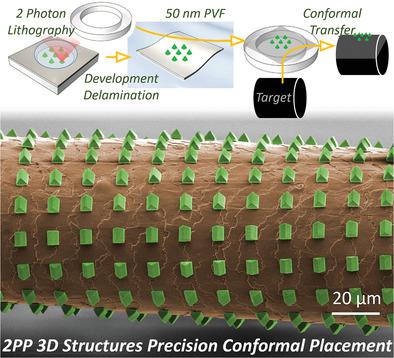当前位置:
X-MOL 学术
›
Adv. Funct. Mater.
›
论文详情
Our official English website, www.x-mol.net, welcomes your
feedback! (Note: you will need to create a separate account there.)
Facile Handling of 3D Two-Photon Polymerized Microstructures by Ultra-Conformable Freestanding Polymeric Membranes
Advanced Functional Materials ( IF 18.5 ) Pub Date : 2023-03-22 , DOI: 10.1002/adfm.202214409
Frank Marco den Hoed 1, 2 , Andrea Ottomaniello 1 , Omar Tricinci 1 , Luca Ceseracciu 3 , Marco Carlotti 1 , Patrizio Raffa 2 , Virgilio Mattoli 1
Advanced Functional Materials ( IF 18.5 ) Pub Date : 2023-03-22 , DOI: 10.1002/adfm.202214409
Frank Marco den Hoed 1, 2 , Andrea Ottomaniello 1 , Omar Tricinci 1 , Luca Ceseracciu 3 , Marco Carlotti 1 , Patrizio Raffa 2 , Virgilio Mattoli 1
Affiliation

|
Micro-nano-fabrication on objects with complex surfaces is essential for the development of technologies in the growing fields of flexible electronics and photonics. Various strategies are devised to extend the fabrication from conventional planar substrates to curved ones, however, significant challenges still exist, especially in the framework of 3D printing and additive manufacturing. In this study, a novel technique is presented to realize 3D micro-structures on arbitrary complex surfaces providing an extreme level of conformability. This method relies on the fabrication of micro-structures via two-photon polymerization on polymeric nano-membranes that can be efficiently transferred to a specific target. Ultra-thin polymeric films are exploited as the support to suspend and transfer the printed micro-structures on the predefined surface. The nanofilm can finally be easily removed, apart from the region underneath the printed elements where it serves as a few tens of nanometers adhesive. The repeatability and feasibility of the proposed process are investigated and shown to provide large flexibility of choice on the printed structures, materials used, transfer procedures, and targeted substrate geometries. By integration with standard fabrication processes, the described technique offers a great potential for the development of next-generation multidimensional/multi-material micro-nano-technologies.
中文翻译:

通过超适形独立聚合物膜轻松处理 3D 双光子聚合微结构
在具有复杂表面的物体上进行微纳米制造对于不断发展的柔性电子和光子学领域的技术发展至关重要。设计了各种策略来将制造从传统的平面基板扩展到曲面基板,但是,仍然存在重大挑战,尤其是在 3D 打印和增材制造的框架中。在这项研究中,提出了一种新技术,可在任意复杂表面上实现 3D 微结构,从而提供极高的一致性。该方法依赖于通过聚合物纳米膜上的双光子聚合来制造微结构,可以有效地转移到特定目标。超薄聚合物薄膜被用作在预定表面上悬浮和转移印刷微结构的支撑。纳米薄膜最终可以很容易地去除,除了印刷元素下方的区域,它用作几十纳米的粘合剂。所提出的工艺的可重复性和可行性得到了研究,并显示出在印刷结构、使用的材料、转移程序和目标基板几何形状方面提供了很大的选择灵活性。通过与标准制造工艺的集成,所描述的技术为下一代多维/多材料微纳米技术的发展提供了巨大的潜力。所提出的工艺的可重复性和可行性得到了研究,并显示出在印刷结构、使用的材料、转移程序和目标基板几何形状方面提供了很大的选择灵活性。通过与标准制造工艺的集成,所描述的技术为下一代多维/多材料微纳米技术的发展提供了巨大的潜力。所提出的工艺的可重复性和可行性得到了研究,并显示出在印刷结构、使用的材料、转移程序和目标基板几何形状方面提供了很大的选择灵活性。通过与标准制造工艺的集成,所描述的技术为下一代多维/多材料微纳米技术的发展提供了巨大的潜力。
更新日期:2023-03-26
中文翻译:

通过超适形独立聚合物膜轻松处理 3D 双光子聚合微结构
在具有复杂表面的物体上进行微纳米制造对于不断发展的柔性电子和光子学领域的技术发展至关重要。设计了各种策略来将制造从传统的平面基板扩展到曲面基板,但是,仍然存在重大挑战,尤其是在 3D 打印和增材制造的框架中。在这项研究中,提出了一种新技术,可在任意复杂表面上实现 3D 微结构,从而提供极高的一致性。该方法依赖于通过聚合物纳米膜上的双光子聚合来制造微结构,可以有效地转移到特定目标。超薄聚合物薄膜被用作在预定表面上悬浮和转移印刷微结构的支撑。纳米薄膜最终可以很容易地去除,除了印刷元素下方的区域,它用作几十纳米的粘合剂。所提出的工艺的可重复性和可行性得到了研究,并显示出在印刷结构、使用的材料、转移程序和目标基板几何形状方面提供了很大的选择灵活性。通过与标准制造工艺的集成,所描述的技术为下一代多维/多材料微纳米技术的发展提供了巨大的潜力。所提出的工艺的可重复性和可行性得到了研究,并显示出在印刷结构、使用的材料、转移程序和目标基板几何形状方面提供了很大的选择灵活性。通过与标准制造工艺的集成,所描述的技术为下一代多维/多材料微纳米技术的发展提供了巨大的潜力。所提出的工艺的可重复性和可行性得到了研究,并显示出在印刷结构、使用的材料、转移程序和目标基板几何形状方面提供了很大的选择灵活性。通过与标准制造工艺的集成,所描述的技术为下一代多维/多材料微纳米技术的发展提供了巨大的潜力。































 京公网安备 11010802027423号
京公网安备 11010802027423号